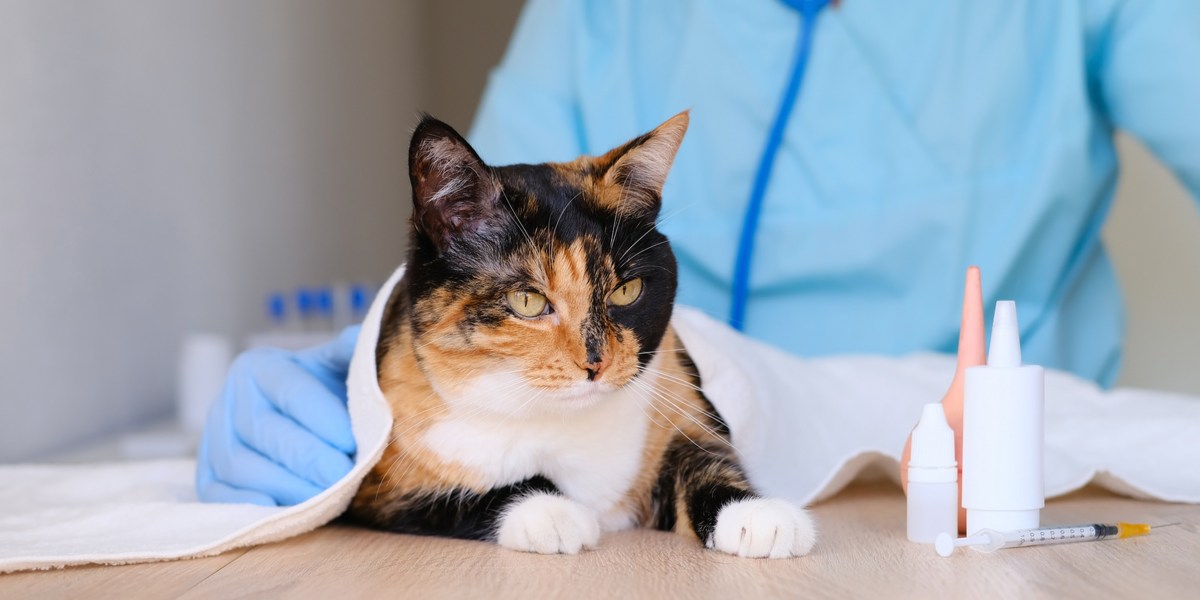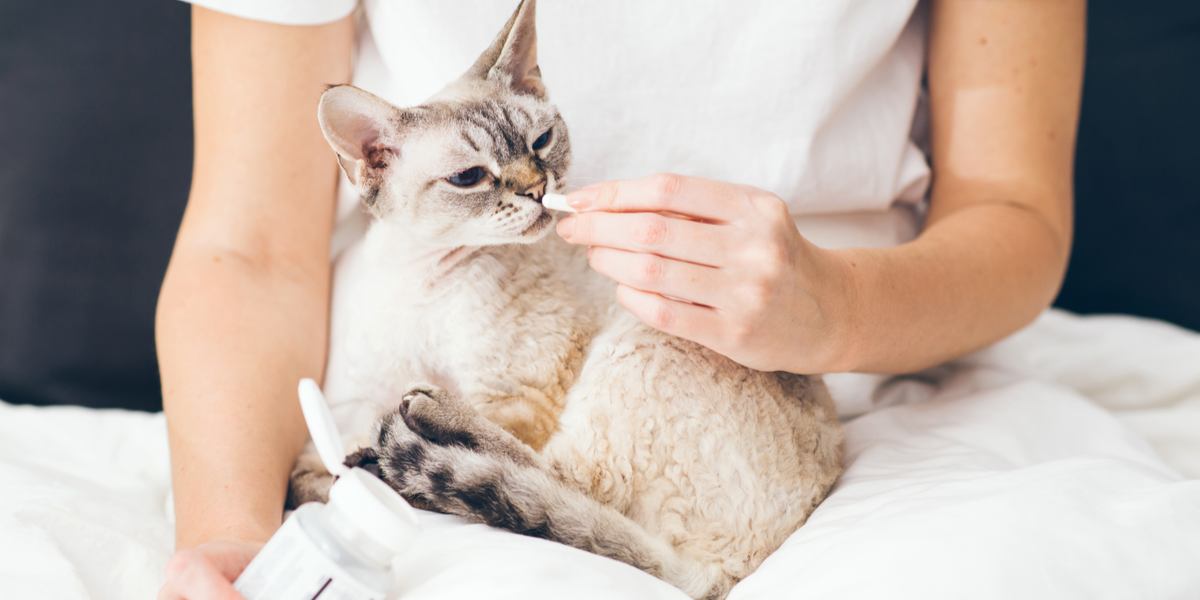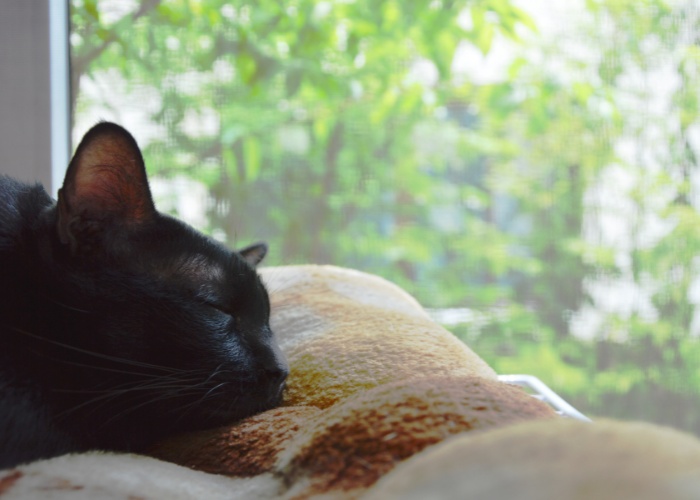
Benadryl, which is a brand name for the drug diphenhydramine hydrochloride, is an antihistamine used to treat symptoms of allergies in cats, including swelling, itching, sneezing and hives, that result from insect bites or stings, exposure to environmental allergens like grass or pollen, and reactions to flea bites or vaccines.
Benadryl For Cats Overview

Antihistamines block histamine receptors in the body that are responsible for initiating allergic reactions. Read on to find answers to the most common questions about Benadryl for cats.
Is Benadryl Safe for Cats?
Benadryl is generally considered to be safe for cats. However, as with all medications, Benadryl should be used correctly.
It’s best to call your veterinarian to ask about using Benadryl for your cat because some cats should not take Benadryl, including cats with certain medical conditions (for instance, heart problems or glaucoma), those taking other medications, pregnant or nursing cats, and cats who are allergic to diphenhydramine.
If you are using Benadryl because your cat is having an allergic reaction or experiencing itchy skin, always follow up with your veterinarian. Benadryl will treat a cat’s symptoms (swelling, itching, sneezing, hives), but it doesn’t treat the underlying cause of the swelling or itching.
For instance, your cat might be suffering from an allergy to flea bites, but simply treating the cat for the itching without addressing the flea infestation will not cure your cat.
Additionally, cats that are scratching and chewing due to allergies or another skin condition need additional medical care to help address the primary reason for the itching, as well as to treat secondary conditions that might have developed, like skin infections.
In cases of severe allergic reactions (anaphylaxis), cats experience such signs as facial swelling, difficulty breathing, vomiting, diarrhea, lethargy, seizures or collapse.
These severe reactions, which can be caused by the sting of wasps or bees or bite of insects or snakes, require urgent veterinary attention. Benadryl is not enough to reduce severe allergic reactions.
If your cat is experiencing a severe allergic reaction, bring her to a veterinarian immediately. If this happens after normal business hours and your veterinary clinic is closed, bring your cat to the nearest emergency veterinary hospital.
Also Read: 8 Best Flea Treatment For Cats- Knock Out Fleas With These Safe Treatments
Ask a Vet
 If you can’t bring your cat to a veterinarian right now you may want to contact a vet on JustAnswer.
For between $10 and $100, this service allows you to connect one-on-one with a real veterinarian in real time. It’s one of the best ways to get personalized expert advice at a fraction of the cost of a vet visit.
If you can’t bring your cat to a veterinarian right now you may want to contact a vet on JustAnswer.
For between $10 and $100, this service allows you to connect one-on-one with a real veterinarian in real time. It’s one of the best ways to get personalized expert advice at a fraction of the cost of a vet visit.
Side Effects of Benadryl in Cats
It is possible for some cats to experience side effects when taking Benadryl.
Some common side effects of Benadryl that you might notice in your cat include:
Cats will usually show signs of unwanted side effects within one hour of taking Benadryl.
If you notice your cat exhibiting any of the above signs while taking Benadryl, stop giving the medication and contact your veterinarian for what you should do.
Although some cats become drowsy when taking Benadryl, others become amped up. For this reason, giving Benadryl to cats for anxiety or for sedation is not recommended.
Benadryl Overdose
Even though Benadryl is usually considered to be safe for cats, it is possible overdose your cat with Benadryl. Avoid giving a lethal dose of Benadryl by weighing your cat before giving the medication and giving only the recommended amount of Benadryl.
Never give more than 1 milligram of Benadryl per pound of body weight and never give Benadryl more often than every eight hours in a 24-hour period. Giving more than the recommended dose of Benadryl or giving too many doses in a 24-hour period increases the risk of Benadryl overdose in cats.
As with all medications, use Benadryl for cats cautiously and carefully, and always with the guidance of your veterinarian.
Signs of Benadryl overdose in cats may include one or more of the following:
- Rapid breathing
- Slow breathing
- Difficulty breathing
- Rapid heartbeat
- Seizures
- Unconsciousness
- Death
How Much Benadryl Can I Give My Cat?
You can buy Benadryl over-the-counter at most pharmacies, grocery stores and big-box stores. Benadryl is sold as tablets or liquid. It’s important to use only plain Benadryl.
The only active ingredient should be diphenhydramine HCl. Never use combination medications (for instance, diphenhydramine combined with a decongestant).
The typical dosage of Benadryl for cats is 1 milligram per pound of body weight. Depending on what the Benadryl is being used to treat, cats may take Benadryl up to three times a day (every eight hours in a 24-hour period). Consult with your veterinarian to find out how often your cat can safely take Benadryl.
Benadryl tablets come in 25 mg. If your cat weighs 12.5 pounds (give or take a pound or so), you can break one tablet in half and give that to your cat.
It gets trickier for cats weighing much less than 12.5 pounds or much more than 12.5 pounds (unless your cat is quite large—a 25- pound cat can take a full 25 mg tablet of Benadryl).
Liquid Benadryl for cats might be easier to measure and also easier to give to a cat (cats are notoriously difficult to get to swallow pills).
Your veterinarian might sell special liquid Benadryl for cats, or you can use children’s Benadryl. Be sure to check with your veterinarian to make sure all of the inactive ingredients in over-the-counter liquid diphenhydramine are safe for cats.
How To Give Benadryl to Cats?

If giving Benadryl tablets, hold your cat in your lap or place her up on a table. Carefully point your cat’s head toward the ceiling, open your cat’s mouth by placing one finger on the lower teeth and quickly place the pill as far back into the throat as possible.
Then, allow your cat to close her mouth and gently stroke her under the chin to encourage her to swallow the pill. Hold your cat’s mouth closed until you know that she has swallowed the pill.
If giving liquid Benadryl, use the measuring syringe included in the package to measure the correct dose of Benadryl.
Position the syringe just inside her mouth, behind one of her canine teeth. Aim the syringe far back into the mouth to the back of the tongue, then gently and slowly squirt the liquid into your cat’s mouth, giving your cat time to swallow and breathe.
Whether giving tablets or liquid, softly blowing on your cat’s face and nose may help encourage your cat to swallow the Benadryl. Alternatively, you can try hiding a tablet into food or mixing liquid into food.
Be aware that, in general, cats dislike the taste of Benadryl, regardless of whether it is in liquid or tablet form. Consider working with a compounding pharmacy, which might be able to make a liquid Benadryl in a flavor that cats like. If you want to go this route, ask your veterinarian to recommend a compounding pharmacy.
Benadryl for Cats Dosage Chart
| Cat’s weight | Benadryl (mg) | Liquid (12.5 mg per 5 mL) | Tablets (25 mg) |
|---|---|---|---|
| 6 pounds | 6 mg | 2.5 mL | 1/4 tablet |
| 8 pounds | 8 mg | 3 mL | 1/4 tablet |
| 10 pounds | 10 mg | 4 mL | 1/4 tablet |
| 12 pounds | 10 mg | 4 mL | 1/2 tablet |
| 15 pounds | 15 mg | 6 mL | 1/2 tablet |
| 20 pounds | 20 mg | 8 mL | 1/2 tablet |
| 25 pounds | 25 mg | 10 mL | 1 tablet |
Calculate Your Cat’s Dosage
Learn the exact amount of Benadryl your cat needs to prevent an overdose
The Result
Use Benadryl for Cats Safely

Benadryl for cats can safely and effectively help if your cat is itchy, sneezing or experiencing swelling. However, even though Benadryl is easy to obtain and give to your cat at home, it is vital that you seek veterinary care for your cat as soon as possible.
This article is for informational purposes only and is not intended to be a substitute for professional veterinary care. Always talk to your veterinarian about questions you may have regarding your pet’s medical condition. Do not delay seeking professional veterinary advice because of something read on the internet.
-
https://www.merckvetmanual.com/pharmacology/systemic-pharmacotherapeutics-of-the-integumentary-system/antihistamines-for-integumentary-disease?query=diphenhydramine%20dose
-
https://www.1800petmeds.com/Diphenhydramine+%28Generic+Benadryl%29-prod10834.html
-
https://www.petmd.com/cat/general-health/can-you-give-cat-benadryl
-
https://www.merckvetmanual.com/pharmacology/systemic-pharmacotherapeutics-of-the-integumentary-system/antihistamines-for-integumentary-disease?query=diphenhydramine%20dose
-
https://www.merckvetmanual.com/toxicology/toxicities-from-human-drugs/cold-and-cough-medications-toxicity
-
https://www.wedgewoodpharmacy.com/learning-center/professional-monographs/diphenhydramine-for-veterinary-use.html
-
https://www.merckvetmanual.com/pharmacology/systemic-pharmacotherapeutics-of-the-integumentary-system/antihistamines-for-integumentary-disease?query=diphenhydramine%20dose








Did a vet confirm these dosages? I was told that since cats are not people the dosage is different. The average cat should only get 2-4mg.
Hi Tamie! Thank you so much for visiting and asking this important question. According to the Merck Veterinary Manual, typical dosing for diphenhydramine (Benadryl) for cats is 2 to 4 milligrams per kilogram of body weight, which works out to about 1 to 2 milligrams per pound of body weight. The link to the Merck Veterinary Manual web page that contains this information is linked in the article. In this article we reference the low end of the recommended dosage (1 milligram per pound of body weight). Although, diphenhydramine (Benadryl) is generally considered to be safe, you should always consult with your veterinarian before giving your cat any medication, including Benadryl.
Since they are easily cut into quarters and halves, I purchased children’s Benadryl chewable tablets for my cat, but forgot that it had Sucralose/splenda in it. Is this sweetener safe for cats? (My cat is 10 years old, and recently diagnosed with congestive heart failure. We have no idea what new allergies she acquired recently, that are causing her to scratch her ears and face.)
Hi Donna! Thank you for stopping by! Although sucralose/Splenda is not generally considered problematic for cats in small amounts, it’s still a good idea to double check with your veterinarian, especially if there are any other ingredients in the particular formula. Additionally, your veterinarian can advise you if Benadryl is safe to give your cat considering she was recently diagnosed with congestive heart failure. If she is taking any new medications for the congestive heart failure, ask your veterinarian if it’s possible that they might be contributing to her itchy face and ears. I hope your cat feels better soon!
Donna, not sure about Splenda, but anything that has xylitol is toxic to cats. Just remember the X in xylitol is toXic. Best of luck to you!
Can I name a boy cat sheba?
I don’t see why not. 🙂
It’s your cat, who gives a f if it’s what you want to do. I suppose if it bugs you “heba” might be more sex friendly.
what is the best way to keep a cat hydrated for a 10 hour trip to another state in uhaul truck? i’m afraid she’ll dart if i open the carrier. i live in vegas and going to california so heat is a concern.
Hi Wendy, good question. This article has a number of good tips, but I’d encourage putting ice cubes in your cat’s bowl, giving them a cooling mat, providing a bowl of water that won’t tip or splash, and feeding wet food prior to and during the trip. Remember that you’ll have to provide bathroom accommodations for your cat as well, so you’ll want to consider the risk of her darting during a bathroom break as well.
Will benadryl help a cat with asthma if the cause is allergies?
Hi Tiffannie, that’s a good question. I’ve not found anything on whether or not Benadryl can help with asthma associated with allergies. I’d recommend talking to your veterinarian about whether or not this can help. I’m sorry I couldn’t be of more help. Best, Mallory
My cat Smokie has to have two shots every month for his mouth pain. I have had him in for dental surgery and they removed a couple of teeth but he gets these sores. He’s ok until the third week of the month and then it starts hurting again. They only let me have him get the shots once a month. Am I being selfish by keeping him alive? I love him and will be devastated to lose him but I need to do the right thing for him. Thank you.
Hello Barbara, thank you for the comment. What kind of sores are these? Is there any chance you could find a permanent or long-term solution? I wouldn’t assume that one painful week per month means that his entire life is no longer worth living (think about what many women go through for a huge chunk of their lives!) That said, I don’t fully understand the situation, and this is a conversation between you, Smokie, and your vet. You might appreciate our article on deciding when to euthanize a cat.
How many days benadryl injection should give to a cat
I would consult a veterinarian about that.
Any tips for driving cross country from San Francisco to Northern Florida with my 6-year-old female cat. She is very health indoor/outdoor cat. I have a litter box ready a harness and leash. Would you suggest leaving her in the cat carrier the whole time while cars in motion? Can she wander about a little to stretch? How often should we offer a bathroom break. (At home she lets me know with a different meow when she needs to use the litter box in the garage because it’s raining outside. I wonder if she’ll do the same. She has only road in the car for vet visits for vaccinations, which is maybe a 10-minute drive. Look now for pet friendly hotels along the I 10! We also thought about renting a camper van to not have to much change for the cat daily?